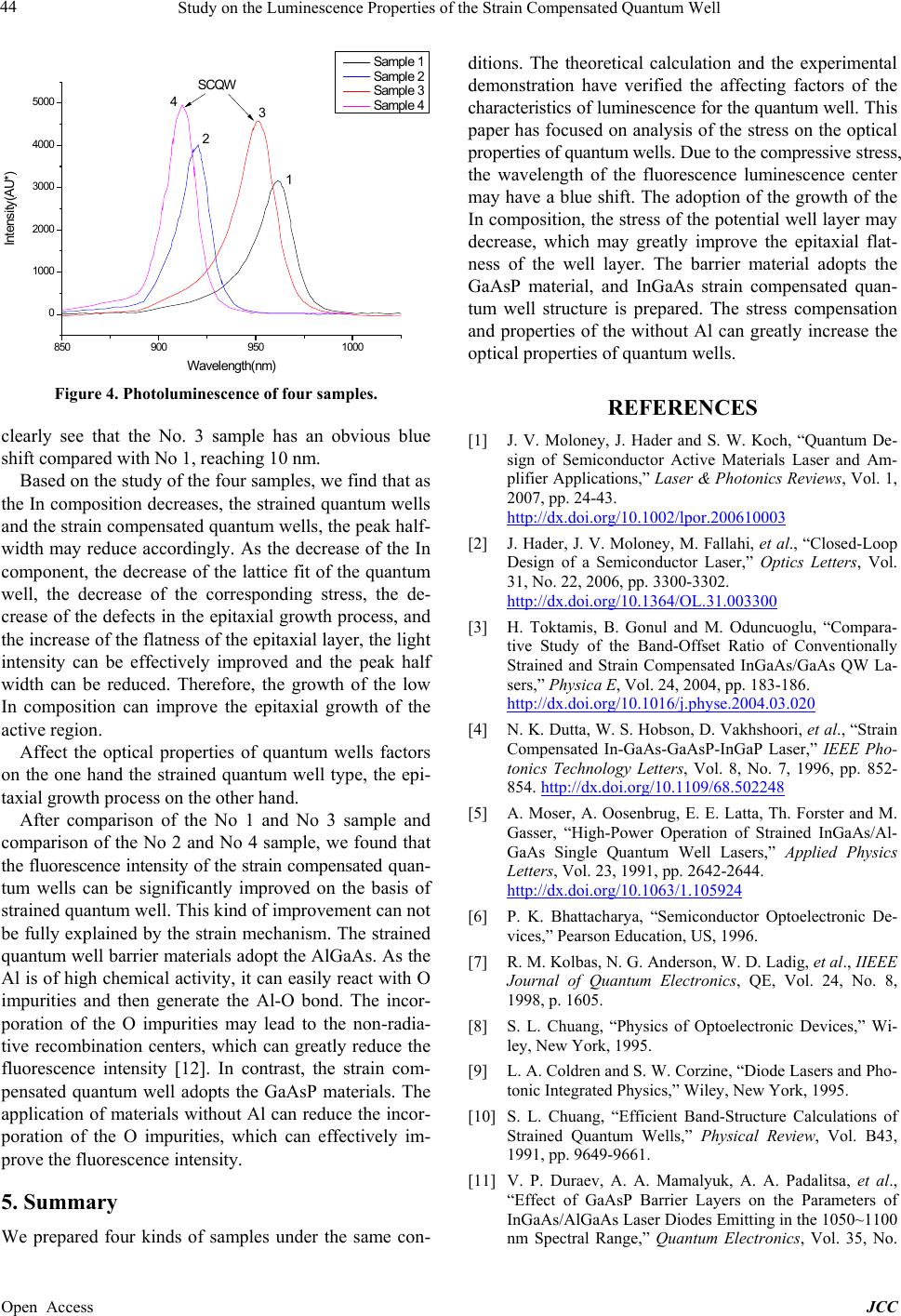
Study on the Luminescence Properties of the Strain Compensated Quantum Well
Open Access JCC
850900950 1000
0
1000
2000
3000
4000
5000
43
2
Intensit y(AU*)
Wavelength(nm)
S am ple 1
S am ple 2
S am ple 3
S am ple 4
1
SCQW
Figure 4. Photoluminescence of four samples.
clearly see that the No. 3 sample has an obvious blue
shift compared with No 1, reaching 10 nm.
Based on the study of the four samples, we find that as
the In composition decreases, the strained quantum wells
and the strain compensated quantum wells, the peak half-
width may reduce accordingly. As the decrease of the In
component, the decrease of the lattice fit of the quantum
well, the decrease of the corresponding stress, the de-
crease of the defects in the epitaxial growth process, and
the increase of the flatness of the epitax ial layer, the light
intensity can be effectively improved and the peak half
width can be reduced. Therefore, the growth of the low
In composition can improve the epitaxial growth of the
active region.
Affect the optical properties of quantum wells factors
on the one hand the strained quantum well type, the epi-
taxial growth proce ss on the o ther hand .
After comparison of the No 1 and No 3 sample and
comparison of the No 2 and No 4 sample, we found that
the fluorescenc e intensity of the strain comp ensated quan-
tum wells can be significantly improved on the basis of
strained quantum well. This kind of improvement can not
be fully explained by the strain mechanism. The strained
quantum well barrier materials adop t the AlGaAs. As the
Al is of high chemical activity, it can easily react with O
impurities and then generate the Al-O bond. The incor-
poration of the O impurities may lead to the non-radia-
tive recombination centers, which can greatly reduce the
fluorescence intensity [12]. In contrast, the strain com-
pensated quantum well adopts the GaAsP materials. The
application of materials without Al can reduce the incor-
poration of the O impurities, which can effectively im-
prove the fluorescence intensity.
5. Summary
We prepared four kinds of samples under the same con-
ditions. The theoretical calculation and the experimental
demonstration have verified the affecting factors of the
characteristics of luminescen ce for the qu antum well. This
paper has focused on analysis of the stress on the optical
properties of quantum we lls. Due to t he c ompressi ve stress,
the wavelength of the fluorescence luminescence center
may have a blue shift. The adoption of the growth of the
In composition, the stress of the potential well layer may
decrease, which may greatly improve the epitaxial flat-
ness of the well layer. The barrier material adopts the
GaAsP material, and InGaAs strain compensated quan-
tum well structure is prepared. The stress compensation
and properties of the without Al can greatly increase the
optical properties of quantu m wells.
REFERENCES
[1] J. V. Moloney, J. Hader and S. W. Koch, “Quantum De-
sign of Semiconductor Active Materials Laser and Am-
plifier Applications,” Laser & Photonics Reviews, Vol. 1,
2007, pp. 24-43.
http://dx.doi.org/10.1002/lpor.200610003
[2] J. Hader, J. V. Moloney, M. Fallahi, et al., “Closed-Loop
Design of a Semiconductor Laser,” Optics Letters, Vol.
31, No. 22, 2006, pp. 3300-3302.
http://dx.doi.org/10.1364/OL.31.003300
[3] H. Toktamis, B. Gonul and M. Oduncuoglu, “Compara-
tive Study of the Band-Offset Ratio of Conventionally
Strained and Strain Compensated InGaAs/GaAs QW La-
sers,” Physica E, Vol. 24, 2004, pp. 183-186.
http://dx.doi.org/10.1016/j.physe.2004.03.020
[4] N. K. Dutta, W. S. Hobson, D. Vakhshoori, et al., “Strain
Compensated In-GaAs-GaAsP-InGaP Laser,” IEEE Pho-
tonics Technology Letters, Vol. 8, No. 7, 1996, pp. 852-
854. http://dx.doi.org/10.1109/68.502248
[5] A. Moser, A. Oosenbrug, E. E. Latta, Th. Forster and M.
Gasser, “High-Power Operation of Strained InGaAs/Al-
GaAs Single Quantum Well Lasers,” Applied Physics
Letters, Vol. 23, 1991, pp. 2642-2644.
http://dx.doi.org/10.1063/1.105924
[6] P. K. Bhattacharya, “Semiconductor Optoelectronic De-
vices,” Pearson Education, US, 1996.
[7] R. M. Kolbas, N. G. Anderson, W. D. Ladig, et al., IIEEE
Journal of Quantum Electronics, QE, Vol. 24, No. 8,
1998, p. 1605.
[8] S. L. Chuang, “Physics of Optoelectronic Devices,” Wi-
ley, New York , 1995.
[9] L. A. Coldren and S. W. Corzine, “Diode Lasers and Pho-
tonic Integrated Physics,” Wiley, Ne w Yor k , 1995.
[10] S. L. Chuang, “Efficient Band-Structure Calculations of
Strained Quantum Wells,” Physical Review, Vol. B43,
1991, pp. 9649-9661.
[11] V. P. Duraev, A. A. Mamalyuk, A. A. Padalitsa, et al.,
“Effect of GaAsP Barrier Layers on the Parameters of
InGaAs/AlGaAs Laser Diodes Emitting in the 1050~1100
nm Spectral Range,” Quantum Electronics, Vol. 35, No.